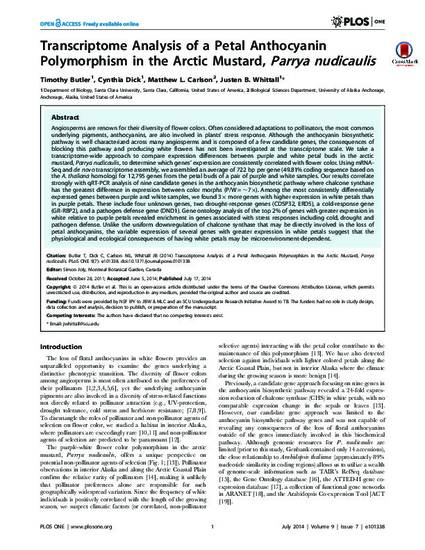
Angiosperms are renown for their diversity of flower colors. Often considered adaptations to pollinators, the most common underlying pigments, anthocyanins, are also involved in plants’ stress response. Although the anthocyanin biosynthetic pathway is well characterized across many angiosperms and is composed of a few candidate genes, the consequences of blocking this pathway and producing white flowers has not been investigated at the transcriptome scale. We take a transcriptome-wide approach to compare expression differences between purple and white petal buds in the arctic mustard, Parrya nudicaulis, to determine which genes’ expression are consistently correlated with flower color. Using mRNASeq and de novo transcriptome assembly, we assembled an average of 722 bp per gene (49.81% coding sequence based on the A. thaliana homolog) for 12,795 genes from the petal buds of a pair of purple and white samples. Our results correlate strongly with qRT-PCR analysis of nine candidate genes in the anthocyanin biosynthetic pathway where chalcone synthase has the greatest difference in expression between color morphs (P/W =,76). Among the most consistently differentially expressed genes between purple and white samples, we found 36more genes with higher expression in white petals than in purple petals. These include four unknown genes, two drought-response genes (CDSP32, ERD5), a cold-response gene (GR-RBP2), and a pathogen defense gene (DND1). Gene ontology analysis of the top 2% of genes with greater expression in white relative to purple petals revealed enrichment in genes associated with stress responses including cold, drought and pathogen defense. Unlike the uniform downregulation of chalcone synthase that may be directly involved in the loss of petal anthocyanins, the variable expression of several genes with greater expression in white petals suggest that the physiological and ecological consequences of having white petals may be microenvironment-dependent.

Copyright: 2014 Butler et al. This is an open-access article distributed under the terms of the Creative Commons Attribution License, which permits unrestricted use, distribution, and reproduction in any medium, provided the original author and source are credited.